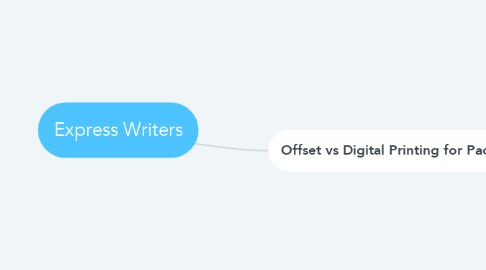
1. Offset vs Digital Printing for Packaging
1.1. Introduction
1.1.1. What is best for your project?
1.2. Offset Print: Classical Technique
1.2.1. Briefly what is Offset
1.2.2. Process of Offset
1.2.3. Benefits & Drawbacks
1.3. Digital Print: Modern Technique
1.3.1. Briefly what is Offset
1.3.2. Process of Offset
1.3.3. Benefits & Drawbacks
1.4. Which One To Use For Your Packaging?
1.4.1. Type of Material?
1.4.1.1. Rigid Box
1.4.1.1.1. Offset Is Best Used
1.4.1.2. Corrugated
1.4.1.2.1. Digital
1.4.1.2.2. Offset
1.4.1.3. Paperboard
1.4.1.3.1. Offset is Best Used
1.4.2. Turnaround Time?
1.4.2.1. Digital Printing typically the best choice for corrugated packaging for small runs but for all long runs (in each material) offset is the choice.
1.4.3. Type of Artwork and Colors?
1.4.3.1. Digital
1.4.3.1.1. For Simple CMYK color specifically for corrugated boxes, Digital is the way to go (in low volume)
1.4.3.2. Offset
1.4.3.2.1. If you are looking for white print on kraft, clear greyscale flood printing and more intricate designs, offset is the way to go
1.4.3.2.2. Offset also provides PMS (Pantone Matching Color System) which allows you to match perfect inks while Digital only provides approximate CMYK representation of a color.
1.4.4. Type Of Coating
1.4.4.1. Digital
1.4.4.1.1. Gloss Varnish or No Coating
1.4.4.2. Offset
1.4.4.2.1. Matte & Gloss Lamination, Soft Touch, Aqueous
1.4.5. Prototyping
1.4.5.1. Digital holds the advantage as it is faster and more cost-effective to make, although the rest of the production run may not match the color 100% (for paperboard & rigid).
1.4.5.1.1. It is mainly for structural approval
1.4.5.1.2. Best to request a CTP Proof to confirm exact printing output on packaging
1.4.5.2. Full Production Grade Offset Printing Sample is timely & costly which is why it is rarely requested
